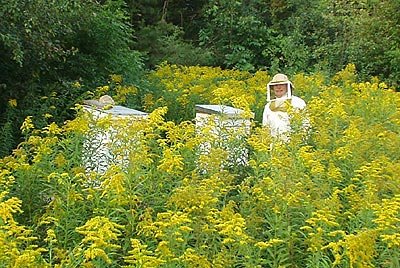
These limbs were too small for lumber.
Last week Tim and I drove north about 30 minutes to Fairfax VT, home of the Vermont Food Venture Center. The VFVC is a non-profit shared-use kitchen for local producers to create their products. There is an entrepreneurial spirit in this area which keeps the kitchens busy. We use the industrial-sized mixers, kettles and bottlers to produce our line of plant medicines. Our mission this time was to make our Wild Cherry Syrup, as the weather cools and demand picks up for relief from colds and flu. As we drive, we notice the leaves are starting to brown a bit. Besides predicting how cold the winter will be, figuring when and how much the leaves will turn is a favorite pastime of Vermonters, old and new. The hot and relatively dry weather up until a couple of weeks ago has turned some of the leaves brown before they could redden.
We unload hundreds of pounds of raw honey, and empty glass bottles, and set up the room to begin mixing. First the honey, then propolis extract is turned into the honey with large stainless steel paddles. It reminds me of the last kayaking trip of the summer. Propolis is a resin gathered by the bees from trees and used in the hive to create a hygienic environment. We use it for the same purpose in our bodies, to fight off bacteria and viruses. Next in is the organic apple cider vinegar. It is a general health tonic, and especially supportive of the respiratory system in fighting off colds and flu. Last into the kettle are the extracts of wild cherry bark, elecampane and ginger roots, rose hips, licorice and slippery elm bark. These herbs help to expel mucus from the lungs and sinuses, sooth our respiratory tracts, and boost immunity. We continue to paddle. Once the mixture is in bottles, we use droppers to add essential oils of lemon, peppermint and eucalyptus. We do this to each bottle individually right before capping so that the oils are not lost to volatilization. As we rhythmically drop the final medicine in to each bottle the conversation between Tim and me turns to healing, and how we can improve our own health by quieting our minds.
We clean up, pack up and head back to the honey house to unload. As we pass the drying wildflowers along the road, I think of what a beautiful summer it has been. “This summer was so hot, I bet the winter is going to be brutal”, I say. Tim agrees, “The earth gave us a great bounty so that we could make it through until the spring.” Indeed. I will think of those hot days during the long nights of winter.
My path as an aspiring herbalist has brought me to the Honey Garden’s family in time to join in the fall harvest. As the bees work to build up a secure winter cache, we work hard beside them, insuring their winter survival while also gathering honey. When I first arrived, I had been diagnosed with Lyme’s Disease, received from a deer tick while in the Pine Barrens of New Jersey. With my energy low and joints stiff, work on some days was quite painful. At Honey Gardens, I soon became aware of the historical treatment called Bee Venom Therapy, where bee stings on varying pressure points and meridians of the body can help to remedy ailments such as multiple sclerosis, rheumatoid, Lyme’s Disease, and cancer. After being stung for several weeks now, I feel a dramatic increase in life energy and decrease in stiffness in my joints.

Some believe that the bees have a divine way of stinging you where it is needed the most. This has been my experience. On a two-day trip last week to gather honey, I received a great deal of stings. One memorable sting was when a bee crawled inside my boot and stung my inner ankle, on an acupuncture point where I have been receiving bee venom therapy, known as spleen six.
I truly have been blessed by working with the bees, not only learning more about them and their sweet gifts, but also the strong healing qualities they share with us.
For more on bee venom therapy, see www.apitherapy.org